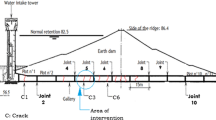Conclusions
-
1.
The dam core, constructed from moraine soil placed in water, was homogeneous from the seepage standpoint and had a dense composition and a low permeability.
-
2.
When the moraine soil is placed in water, a small excess pore pressure develops (10–15% of the weight of the overlying soil), which is very quickly dissipated, within a period of 2–3 days. This circumstance permits eliminating the control of the rate of raising the structure during construction.
-
3.
The rock-fill shells, placed in layers up to 18 m thick, without applying special compaction measures, during the period of dam construction and reservoir filling settled significantly, whose relative value can be estimated at 7–8%, of which 2–3% corresponds to the settlement caused by wetting of the rock fill. The relative value of the settlement of the dam core during the same period was about 1%.
-
4.
Because of the significant difference between settlement of the core and of the shells, sliding of the latter with respect to the core took place. This sliding occurred along the transition layers and was attended by formation of several longitudinal cracks in the shells, the transition layers, and the core.
-
5.
The three-year period of dam operation and the results of full-scale observations showed that the cracks formedin the dam did not cause any complications in the operation of this structure.
Similar content being viewed by others
Literature Cited
P. A. Bukin, Construction of Dams for Northern Hydraulic Developments by Placing Moraine Soil in Water [in Russian], Orgénergostroi, Moscow (1967).
G. A. Khukhlaev, “Construction of rock-earth dam at the Serebrynka hydroelectric plant in the Polar Region,” Gidrotekh. Stroiltel'., No. 8 (1969).
A. F. Vasil'ev, “Basic conclusions from 40-years experience with use of moraine soils in hydraulic engineering on the Kola Peninsula and in Karelia,” Gidrotekh. Stroitel'., No. 8 (1969).
P. A. Bukin, “Characteristics of dams constructed with moraine soils at the hydroelectric developments of the Korda cascade,” Gidrotekh. Stroitel'., Nos. 2 and 4 (1968).
V. S. Kuznetsov and A. I. Liberman, “Investigations of the moraine soil in the core of the Serebrynka dam.” Gidrotekh. Stroitel'., No. 10 (1973).
A. F. Vasil'ev, M. A. Gavrilets, and N. V. Tolokno, “The systems of Serebrynka hydroelectric plants on the Voroniya River,” Gidrotekh. Stroitel'., No. 10 (1973).
Additional information
Translated from Gidrotekhnicheskoe Stroitel'stvo, No. 4, pp. 25–29, April, 1974.
Rights and permissions
About this article
Cite this article
Kuznetsov, V.S. Results of full-scale observations on the dam at the Serebrynka-I hydroelectric plant. Hydrotechnical Construction 8, 325–330 (1974). https://doi.org/10.1007/BF02406939
Issue Date:
DOI: https://doi.org/10.1007/BF02406939




